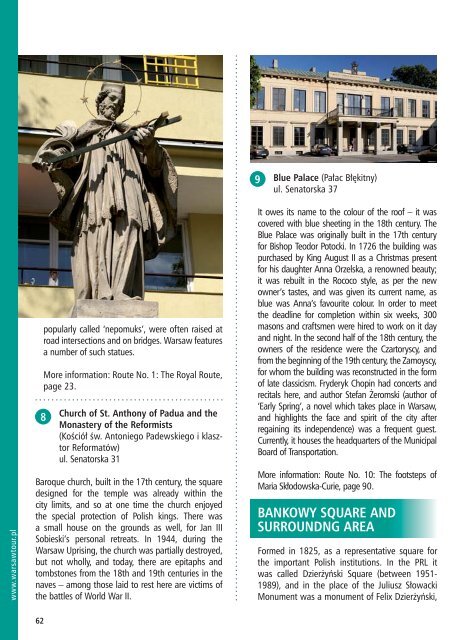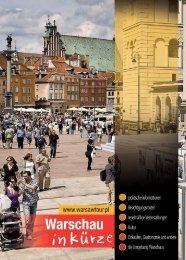You also want an ePaper? Increase the reach of your titles
YUMPU automatically turns print PDFs into web optimized ePapers that Google loves.
www.warsaw<strong>to</strong>ur.pl<br />
62<br />
popularly called ‘nepomuks’, were often raised at<br />
road intersections and on bridges. <strong>Warsaw</strong> features<br />
a number of such statues.<br />
More information: Route No. 1: The Royal Route,<br />
page 23.<br />
8<br />
Church of St. Anthony of Padua and the<br />
Monastery of the Reformists<br />
(Kościół św. An<strong>to</strong>niego Padewskiego i klasz<strong>to</strong>r<br />
Reformatów)<br />
ul. Sena<strong>to</strong>rska 31<br />
Baroque church, built in the 17th century, the square<br />
designed for the temple was already w<strong>it</strong>hin the<br />
c<strong>it</strong>y lim<strong>it</strong>s, and so at one time the church enjoyed<br />
the special protection of Polish kings. There was<br />
a small house on the grounds as well, for Jan III<br />
Sobieski’s personal retreats. In 1944, during the<br />
<strong>Warsaw</strong> Uprising, the church was partially destroyed,<br />
but not wholly, and <strong>to</strong>day, there are ep<strong>it</strong>aphs and<br />
<strong>to</strong>mbs<strong>to</strong>nes from the 18th and 19th centuries in the<br />
naves – among those laid <strong>to</strong> rest here are victims of<br />
the battles of World War II.<br />
9<br />
Blue Palace (Pałac Błęk<strong>it</strong>ny)<br />
ul. Sena<strong>to</strong>rska 37<br />
It owes <strong>it</strong>s name <strong>to</strong> the colour of the roof – <strong>it</strong> was<br />
covered w<strong>it</strong>h blue sheeting in the 18th century. The<br />
Blue Palace was originally built in the 17th century<br />
for Bishop Teodor Po<strong>to</strong>cki. In 1726 the building was<br />
purchased by King August II as a Christmas present<br />
for his daughter Anna Orzelska, a renowned beauty;<br />
<strong>it</strong> was rebuilt in the Rococo style, as per the new<br />
owner’s tastes, and was given <strong>it</strong>s current name, as<br />
blue was Anna’s favour<strong>it</strong>e colour. In order <strong>to</strong> meet<br />
the deadline for completion w<strong>it</strong>hin six weeks, 300<br />
masons and craftsmen were hired <strong>to</strong> work on <strong>it</strong> day<br />
and night. In the second half of the 18th century, the<br />
owners of the residence were the Czar<strong>to</strong>ryscy, and<br />
from the beginning of the 19th century, the Zamoyscy,<br />
for whom the building was reconstructed in the form<br />
of late classicism. Fryderyk Chopin had concerts and<br />
rec<strong>it</strong>als here, and author Stefan Żeromski (author of<br />
‘Early Spring’, a novel which takes place in <strong>Warsaw</strong>,<br />
and highlights the face and spir<strong>it</strong> of the c<strong>it</strong>y after<br />
regaining <strong>it</strong>s independence) was a frequent guest.<br />
Currently, <strong>it</strong> houses the headquarters of the Municipal<br />
Board of Transportation.<br />
More information: Route No. 10: The footsteps of<br />
Maria Skłodowska-Curie, page 90.<br />
BANKOWY SQUARE AND<br />
SURROUNDNG AREA<br />
Formed in 1825, as a representative square for<br />
the important Polish inst<strong>it</strong>utions. In the PRL <strong>it</strong><br />
was called Dzierżyński Square (between 1951-<br />
1989), and in the place of the Juliusz Słowacki<br />
Monument was a monument of Felix Dzierżyński,



